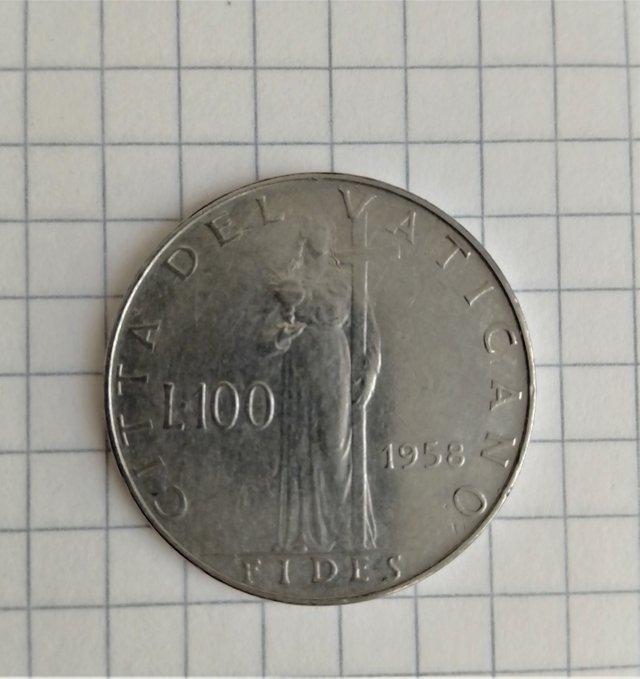Coin Collection #7 "Vatican City 100 lire, 1955-1958" former circulation coins
Pictures


genaral about the vatican city lire
The Vatican lira was the official currency in circulation in Vatican City until 31 December 2001. The portraits of the popes have been depicted on coins for well over 1000 years. As a secular ruler, the Pope regularly issued coins. These were issued in the various currencies ruling at the time, Denar, Florin, Ducat, Doppia and Scudo, until 1866 when the Lira was introduced. From 1866 the Papal States used the lira, which was minted in accordance with the standards of the Latin Monetary Union, before the Papal States were occupied by Italian troops and dissolved in 1870.
In 1929, with the signing of the Lateran Treaties, the Vatican City was founded, which according to the terms of the treaty had the right to introduce its own coins.[1] The Vatican lira was pegged to the Italian lira and divided into 100 centesimi. Italian and San Marino coins and banknotes were also accepted as means of payment in the Vatican City. Conversely, Vatican coins minted at the Italian state mint Istituto Poligrafico e Zecca dello Stato in Rome were legal tender in Italy and in San Marino.
The Vatican City introduced the euro in 2002. The exchange rate was 1 euro = 1936.27 lira. Since then the Vatican City has had its own euro coins minted.
In 1929, 5 and 10 centesimi copper coins, 20 and 50 centesimi coins, 1 and 2 lire nickel coins and 5 and 10 lire silver coins were introduced. There was also a 100 lire gold coin. In 1939 aluminium-bronze replaced copper coins and in 1940 nickel coins were replaced by steel. Between 1941 and 1946, only a few thousand of the above-mentioned nominal values were minted.
The Vatican City introduced new aluminium coins in 1947: 1, 2, 5 and 10 lire. The size of these coins was reduced in 1951 and new 50 and 100 lire steel coins were introduced in 1955. These were followed in 1957 by a 20 lire piece in aluminium-bronze and in 1958 by a 500 lire piece in silver. Production of the 1 and 2 lire coins ceased in 1977, and that of the 5 lire coins in 1978. 200 lire aluminium-bronze and 1000 lire silver coins were introduced in 1978, followed by a 500 lire bimetallic coin in 1982 and a 1000 lire bimetallic coin in 1997. Silver commemorative coins were also minted at 2000, 5000 and 10,000 lire [2].
The 100 lire gold coins were minted continuously from 1929 to 1959. From 1996, commemorative gold coins at 50,000 and 100,000 lire were issued.
Pope Pius XII.
Pius XII (civil name Eugenio Maria Giuseppe Giovanni Pacelli; * 2 March 1876 in Rome; † 9 October 1958 in Castel Gandolfo) was Pope from 2 March 1939 until his death.
The position of Pope Pius XII in the Nazi era has been the subject of controversial discussion since the publication of Rolf Hochhuth's drama Der Stellvertreter in 1963. Since then, the main accusation has been that Pius XII had persistently kept silent about the Holocaust despite numerous requests for public protest, whether out of indifference, German-friendliness or fear of communism.

Fact sheet
| Type of information | specific information |
|---|---|
| Country | Vatican City |
| Value | 100 lire |
| Year | 1955-1958 |
| Age | Papst Pius XII. (1939 - 1958) |
| Coin type | former circulation coin |
| Ruler | Pius XII. |
| Material | Stainless steel |
| Weight | 8g |
| Diameter | 27.75mm |
| Thickness | 2mm |
| Edge | Geriffelt |
| Form | Round |
| Alignment | Coin orientation (180°) |
| Issue limit: | 852.000 |
Observe
- The obverse shows the standing Fides (personification of trust)
- Surrounded by the nominal "L.100"
- The year
- The writing "FIDES"
- The country name "CITTA' DEL VATICANO".
Reverse
- On the lapel there is the bust of Pope Pius XII, looking to the left
- surrounded by the inscription "PIVS.XII.P.M. AN." followed by the numerator of the years in office in Roman numerals
- The signature "GIAMPAOLI" is shown at the bottom edge.